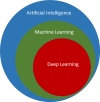State-of-the-Art Machine Learning Techniques Aiming to Improve Patient Outcomes Pertaining to the Cardiovascular System
- PMID: 32067584
- PMCID: PMC7070211
- DOI: 10.1161/JAHA.119.013924
State-of-the-Art Machine Learning Techniques Aiming to Improve Patient Outcomes Pertaining to the Cardiovascular System
Keywords: cardiovascular; deep learning; machine learning; outcomes; review; state of the art.
Figures






References
-
- Henke N, Bughin J, Chui M, Manyika J, Saleh T, Wiseman B, Sethupathy G. The age of analytics: Competing in a data‐driven world. McKinsey Global Institute; December 2016. Available at: https://www.mckinsey.com/business-functions/mckinsey-analytics/our-insig....
-
- Research from Gartner—five ways data science and machine learning deliver business impacts. 2017.
-
- Daquila M. Worldwide Artificial Intelligence Systems Spending 2018–2022 Forecast: Market Opportunity by Industry and Use Case. International Data Corporation; November 2018. Doc # US44430518. Available at: https://www.idc.com/getdoc.jsp?containerId=US44430518.
-
- Russell SJ, Norvig P. Artificial Intelligence: A Modern Approach. Malaysia: Pearson Education Limited; 2016.
-
- LeCun Y, Bengio Y, Hinton G. Deep learning. Nature. 2015;521:436. - PubMed
Publication types
MeSH terms
Grants and funding
LinkOut - more resources
Full Text Sources
Other Literature Sources

